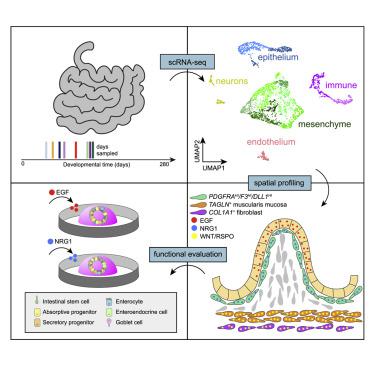Cell Stem Cell ( IF 23.9 ) Pub Date : 2020-12-04 , DOI: 10.1016/j.stem.2020.11.008 Emily M Holloway 1 , Michael Czerwinski 2 , Yu-Hwai Tsai 2 , Joshua H Wu 2 , Angeline Wu 2 , Charlie J Childs 1 , Katherine D Walton 1 , Caden W Sweet 2 , Qianhui Yu 3 , Ian Glass 4 , Barbara Treutlein 5 , J Gray Camp 6 , Jason R Spence 7

|
The human intestinal stem cell niche supports self-renewal and epithelial function, but little is known about its development. We used single-cell mRNA sequencing with in situ validation approaches to interrogate human intestinal development from 7–21 weeks post conception, assigning molecular identities and spatial locations to cells and factors that comprise the niche. Smooth muscle cells of the muscularis mucosa, in close proximity to proliferative crypts, are a source of WNT and RSPONDIN ligands, whereas EGF is expressed far from crypts in the villus epithelium. Instead, an PDGFRAHI/F3HI/DLL1HI mesenchymal population lines the crypt-villus axis and is the source of the epidermal growth factor (EGF) family member NEUREGULIN1 (NRG1). In developing intestine enteroid cultures, NRG1, but not EGF, permitted increased cellular diversity via differentiation of secretory lineages. This work highlights the complexities of intestinal EGF/ERBB signaling and delineates key niche cells and signals of the developing intestine.
中文翻译:

以单细胞分辨率绘制人类肠道生态位的发育图谱
人类肠道干细胞生态位支持自我更新和上皮功能,但对其发育知之甚少。我们使用单细胞 mRNA 测序和原位验证方法来研究受孕后 7-21 周的人类肠道发育,为构成生态位的细胞和因子分配分子身份和空间位置。粘膜肌层的平滑肌细胞靠近增殖性隐窝,是WNT和RSPONDIN配体的来源,而EGF在绒毛上皮中远离隐窝处表达。相反,PDGFRA HI / F3 HI / DLL1 HI间充质群体排列在隐窝绒毛轴上,并且是表皮生长因子 (EGF) 家族成员NEUREGULIN1 ( NRG1 ) 的来源。在开发肠类肠培养物时,NRG1(而非 EGF)通过分泌谱系的分化增加了细胞多样性。这项工作强调了肠道 EGF/ERBB 信号传导的复杂性,并描绘了发育中肠道的关键生态位细胞和信号。



























 京公网安备 11010802027423号
京公网安备 11010802027423号